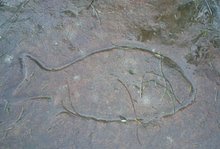 A growing amount of the Earth is sealed with non-absorbent surfaces to ease the flow of automobiles. The result is warmer urban temperatures and polluted water ways.
A growing amount of the Earth is sealed with non-absorbent surfaces to ease the flow of automobiles. The result is warmer urban temperatures and polluted water ways.
Bryan Pijanowski found that in a mid-size shire “...parking spaces outnumbered resident drivers 3-to-1 and outnumbered resident families 11-to-1”. Car parking spaces were “...larger than 1,000 football fields, or covering more than two square miles.” Car parks “... turn out about 1,000 pounds of heavy metal runoff annually ”. Leaking car batteries and airborne fumes all found their way to the impervious surface and then to the next water body.
The temperature in these areas is raised by '2 to 3 degrees Celsius'. The researcher reminds us that 'land is not unlimited ' and we should “ seek a lifestyle that requires less automobile use”.
 Australian research has looked in detail at what is running down these hard surfaces to the beach and other waterways. “Roads make up about one-fifth of the urban land area”. They claim that the run-off is a cocktail of toxic waste. Rain or any other liquids then wash these poisons into the water bodies. “ The dust then enters the waterways, silting up creeks, ponds and wetlands.”
Australian research has looked in detail at what is running down these hard surfaces to the beach and other waterways. “Roads make up about one-fifth of the urban land area”. They claim that the run-off is a cocktail of toxic waste. Rain or any other liquids then wash these poisons into the water bodies. “ The dust then enters the waterways, silting up creeks, ponds and wetlands.”
They found 20 chemicals on Sydney's road surfaces, such as:
- Environmentally persistent chemicals
- Polycyclic aromatic hydrocarbons (PAHs) from “ vehicle exhausts, asphalt roads and fires”
- “ Nicotine, most likely from tossed away cigarette butts, is an alkaloid with a half-life in the environment of 30 days and can be toxic to aquatic organisms”
- “ Trace amounts of heavy metals such as lead and zinc from tyres, petrol and bearings; chromium from wear and tear on car bodies, and copper from brake linings”
- Plasticisers
- “ Phosphorous that leads to algal blooms”
Links:
Convention on POPs











No comments:
Post a Comment